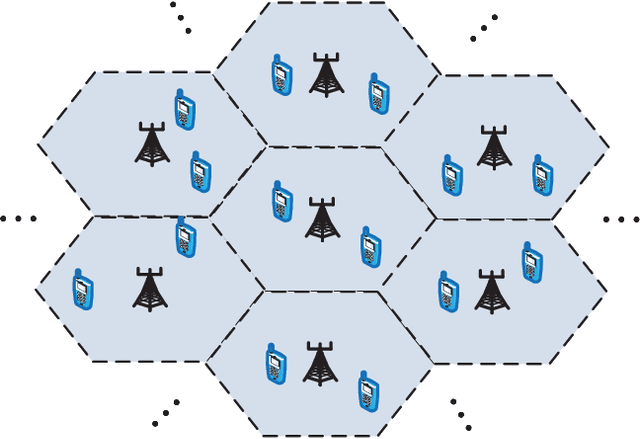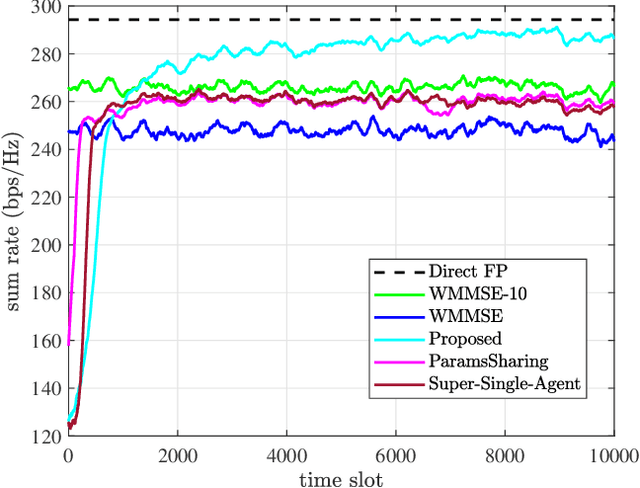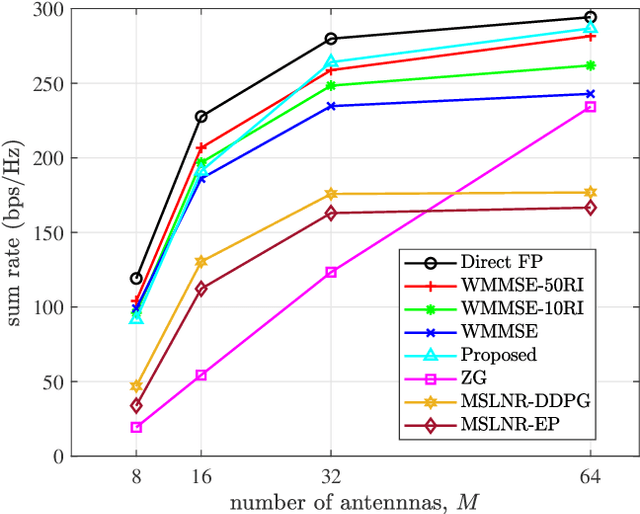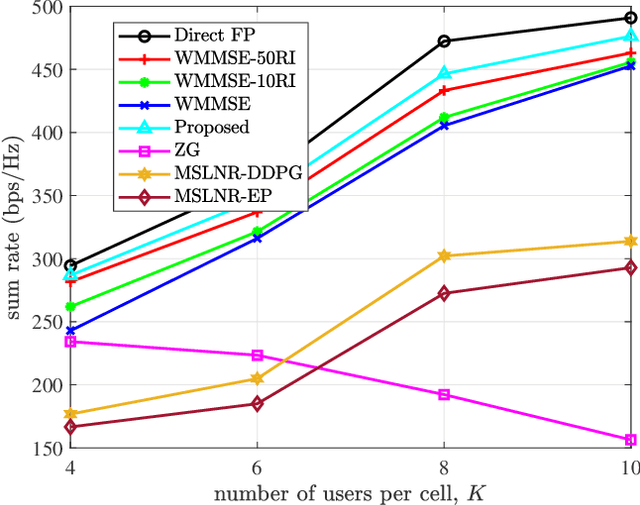Ruizhe Long
Movable Antennas Aided Multicast MISO Communication Systems
May 12, 2024Abstract:A novel multicast communication system with movable antennas (MAs) is proposed, where the antenna position optimization is exploited to enhance the transmission rate. Specifically, an MA-assisted two-user multicast multiple-input single-input system is considered. The joint optimization of the transmit beamforming vector and transmit MA positions is studied by modeling the motion of the MA elements as discrete movements. A low-complexity greedy search-based algorithm is proposed to tackle this non-convex inter-programming problem. A branch-and-bound (BAB)-based method is proposed to achieve the optimal multicast rate with a reduced time complexity than the brute-force search by assuming the two users suffer similar line-of-sight path losses. Numerical results reveal that the proposed MA systems significantly improve the multicast rate compared to conventional fixed-position antennas (FPAs)-based systems.
Power-Aware Sparse Reflect Beamforming in Active RIS-aided Interference Channels
Mar 29, 2024Abstract:Active reconfigurable intelligent surface (RIS) has attracted significant attention in wireless communications, due to its reflecting elements (REs) capable of reflecting incident signals with not only phase shifts but also amplitude amplifications. In this paper, we are interested in active RIS-aided interference channels in which $K$ user pairs share the same time and frequency resources with the aid of active RIS. Thanks to the promising amplitude amplification capability, activating a moderate number of REs, rather than all of them, is sufficient for the active RIS to mitigate cross-channel interferences. Motivated by this, we propose a power-aware sparse reflect beamforming design for the active RIS-aided interference channels, which allows the active RIS to flexibly adjust the number of activated REs for the sake of reducing hardware and power costs. Specifically, we establish the power consumption model in which only those activated REs consume the biasing and operation power that supports the amplitude amplification, yielding an $\ell_0$-norm power consumption function. Based on the proposed model, we investigate a sum-rate maximization problem and an active RIS power minimization problem by carefully designing the sparse reflect beamforming vector. To solve these problems, we first replace the nonconvex $\ell_0$-norm function with an iterative reweighted $\ell_1$-norm function. Then, fractional programming is used to solve the sum-rate maximization, while semidefinite programming together with the difference-of-convex algorithm (DCA) is used to solve the active RIS power minimization. Numerical results show that the proposed sparse designs can notably increase the sum rate of user pairs and decrease the power consumption of active RIS in interference channels.
Pilot Design and Signal Detection for Symbiotic Radio over OFDM Carriers
Nov 06, 2023



Abstract:Symbiotic radio (SR) is a promising solution to achieve high spectrum- and energy-efficiency due to its spectrum sharing and low-power consumption properties, in which the secondary system achieves data transmissions by backscattering the signal originating from the primary system. In this paper, we are interested in the pilot design and signal detection when the primary transmission adopts orthogonal frequency division multiplexing (OFDM). In particular, to preserve the channel orthogonality among the OFDM sub-carriers, each secondary symbol is designed to span an entire OFDM symbol. The comb-type pilot structure is employed by the primary transmission, while the preamble pilot structure is used by the secondary transmission. With the designed pilot structures, the primary signal can be detected via the conventional methods by treating the secondary signal as a part of the composite channel, i.e., the effective channel of the primary transmission. Furthermore, the secondary signal can be extracted from the estimated composite channel with the help of the detected primary signal. The bit error rate (BER) performance with both perfect and estimated CSI, the diversity orders of the primary and secondary transmissions, and the sensitivity to symbol synchronization error are analyzed. Simulation results show that the performance of the primary transmission is enhanced thanks to the backscatter link established by the secondary transmission. More importantly, even without the direct link, the primary and secondary transmissions can be supported via only the backscatter link.
* This paper has been accepted for publication in IEEE Transactions on Wireless Communications
Channel Estimation and Training Design for Active RIS Aided Wireless Communications
Nov 06, 2023


Abstract:Active reconfigurable intelligent surface (ARIS) is a newly emerging RIS technique that leverages radio frequency (RF) reflection amplifiers to empower phase-configurable reflection elements (REs) in amplifying the incident signal. Thereby, ARIS can enhance wireless communications with the strengthened ARIS-aided links. In this letter, we propose exploiting the signal amplification capability of ARIS for channel estimation, aiming to improve the estimation precision. Nevertheless, the signal amplification inevitably introduces the thermal noise at the ARIS, which can hinder the acquisition of accurate channel state information (CSI) with conventional channel estimation methods based on passive RIS (PRIS). To address this issue, we further investigate this ARIS-specific channel estimation problem and propose a least-square (LS) based channel estimator, whose performance can be further improved with the design on ARIS reflection patterns at the channel training phase. Based on the proposed LS channel estimator, we optimize the training reflection patterns to minimize the channel estimation error variance. Extensive simulation results show that our proposed design can achieve accurate channel estimation in the presence of the ARIS noises.
* This paper has been accepted for publication in IEEE Wireless Communications Letters
Modulation Design and Optimization for RIS-Assisted Symbiotic Radios
Nov 02, 2023



Abstract:In reconfigurable intelligent surface (RIS)-assisted symbiotic radio (SR), the RIS acts as a secondary transmitter by modulating its information bits over the incident primary signal and simultaneously assists the primary transmission, then a cooperative receiver is used to jointly decode the primary and secondary signals. Most existing works of SR focus on using RIS to enhance the reflecting link while ignoring the ambiguity problem for the joint detection caused by the multiplication relationship of the primary and secondary signals. Particularly, in case of a blocked direct link, joint detection will suffer from severe performance loss due to the ambiguity, when using the conventional on-off keying and binary phase shift keying modulation schemes for RIS. To address this issue, we propose a novel modulation scheme for RIS-assisted SR that divides the phase-shift matrix into two components: the symbol-invariant and symbol-varying components, which are used to assist the primary transmission and carry the secondary signal, respectively. To design these two components, we focus on the detection of the composite signal formed by the primary and secondary signals, through which a problem of minimizing the bit error rate (BER) of the composite signal is formulated to improve both the BER performance of the primary and secondary ones. By solving the problem, we derive the closed-form solution of the optimal symbol-invariant and symbol-varying components, which is related to the channel strength ratio of the direct link to the reflecting link. Moreover, theoretical BER performance is analyzed. Finally, simulation results show the superiority of the proposed modulation scheme over its conventional counterpart.
Deep Reinforcement Learning for Distributed Dynamic Coordinated Beamforming in Massive MIMO Cellular Networks
Mar 24, 2023



Abstract:To accommodate the explosive wireless traffics, massive multiple-input multiple-output (MIMO) is regarded as one of the key enabling technologies for next-generation communication systems. In massive MIMO cellular networks, coordinated beamforming (CBF), which jointly designs the beamformers of multiple base stations (BSs), is an efficient method to enhance the network performance. In this paper, we investigate the sum rate maximization problem in a massive MIMO mobile cellular network, where in each cell a multi-antenna BS serves multiple mobile users simultaneously via downlink beamforming. Although existing optimization-based CBF algorithms can provide near-optimal solutions, they require realtime and global channel state information (CSI), in addition to their high computation complexity. It is almost impossible to apply them in practical wireless networks, especially highly dynamic mobile cellular networks. Motivated by this, we propose a deep reinforcement learning based distributed dynamic coordinated beamforming (DDCBF) framework, which enables each BS to determine the beamformers with only local CSI and some historical information from other BSs.Besides, the beamformers can be calculated with a considerably lower computational complexity by exploiting neural networks and expert knowledge, i.e., a solution structure observed from the iterative procedure of the weighted minimum mean square error (WMMSE) algorithm. Moreover, we provide extensive numerical simulations to validate the effectiveness of the proposed DRL-based approach. With lower computational complexity and less required information, the results show that the proposed approach can achieve comparable performance to the centralized iterative optimization algorithms.
 Add to Chrome
Add to Chrome Add to Firefox
Add to Firefox Add to Edge
Add to Edge